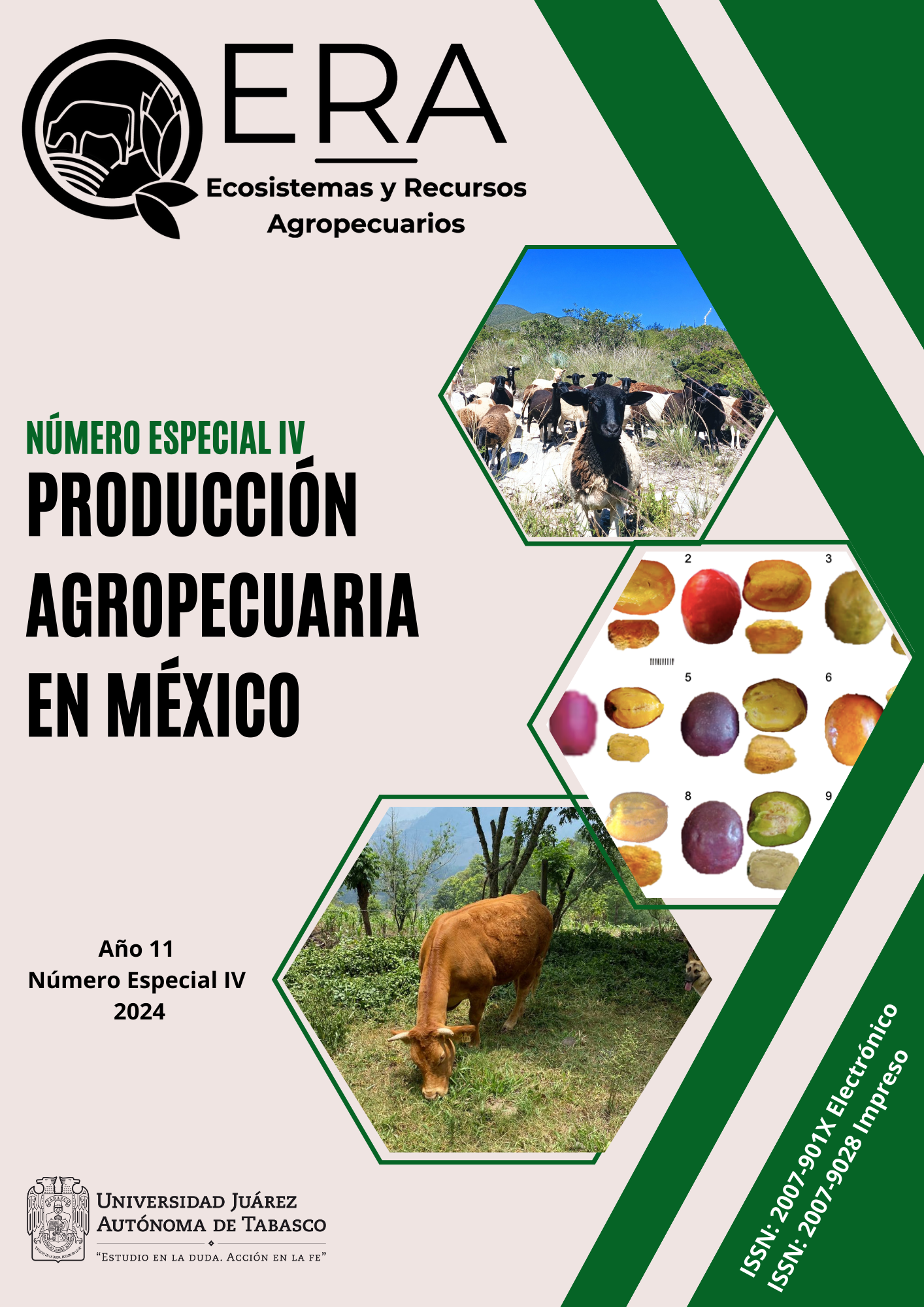Production of shell tomato (Physalis ixocarpa Brot.) with vermicompost and chemical fertilization
DOI:
https://doi.org/10.19136/era.a11nIV.4143Keywords:
Agriculture, conventional, organic, yield, tomatilloAbstract
The use of conventional fertilizers has been a viable production alternative for many years; however, it has caused serious damage to ecosystems. The objective of the present study was to evaluate the effect of chemical, organic and chemical-organic fertilization on morphology, fruit quality and yield of husk tomato under rainfed conditions. The experiment was carried out in completely randomized blocks with four treatments and three repetitions: T1 = 120N-80P-120K, T2 = 3.479 kg m2 of vermicompost, T3 = 120N-80P-120K + 3.479 kg m2 of vermicompost and T4 = witness. The results indicate that treatment 3 (chemical-organic) positively influenced the variables of morphology, yield and pH. The chemical-organic treatment obtained the best results for yield, while the content of total soluble solids did not present a significant difference between treatments. The use of chemical-organic fertilization is a production alternative that has a positive effect on the nutrition of shell tomato.
Downloads
References
Abreu-Cruz E, Araujo-Camacho E, Rodríguez-Jiménez SL, Valdivia-Ávila AL, Fuentes-Alfonso L, Pérez-Hernández Y (2018) Efecto de la aplicación combinada de fertilizante químico y humus de lombriz en Capsicum annuum. Revista Centro Agrícola 45(1): 52-51.
Ahmad M, Tripathi SK (2022) Effect of integrated use of vermicompost, FYM and chemical fertilizers on soil properties and productivity of wheat (Triticum aestivum L.) in alluvial soil. The Journal of Phytopharmacology 11: 101-106.
Aguiñaga-Bravo A, Medina-Dzul K, Garruña-Hernández R, Latournerie-Moreno L, Ruíz-Sánchez E (2020) Efecto de abonos orgánicos sobre el rendimiento, valor nutritivo y capacidad antioxidante de tomate verde (Physalis ixocarpa). Acta Universitaria 30: 1-14. https://doi.org/10.15174/au.202 0.2475.
Ariati AC, Oliveira MC, Edenes MS, Gomes I, Pacheco V, Negri RC (2017) Mineral and organic fertilizer in two Physalis species. African Journal of Agricultural 12(2): 104-110. https://doi.org/10.5897/AJAR2016.11717.
Cruz-Koizumi YP, Alayón-Gamboa JA, Morón-Ríos A (2017) Efecto de la fertilización orgánica y de síntesis química en tomate verde (Physalis ixocarpa Brot. Ex Horn) en Calakmul, Campeche, México. Avances en Investigación Agropecuaria 21(2): 41-53.
Cun GR, Duarte DC, Montero SL (2008) Producción orgánica de tomate mediante la aplicación de humus de lombriz y EcoMic® en condiciones de casa de cultivo. Revista Ciencias Técnicas Agropecuarias 17(3): 22-25.
Di-Rienzo JA, Casanoves F, Balzarini M, González L, Tablada M, Robledo CW (2018) InfoStat, Statistical Software, (2018). Argentina: Universidad Nacional de Córdoba. www.infostat.com.ar. Fecha de consulta: 08 de julio de 2020.
Egbe AE, Soupi MSN, Nkede F, Ndogho AP (2023) Growth, yield and yield characteristics of three pepper cultivars to fertilizers application in the Mount Cameroon Region. Journal of Agricultural Chemistry and Environment 12: 188-205.
Gond M, Dwivedi DH, Maji S (2018) Flowering and fruiting in cape gooseberry (Physalis peruviana L.) as influenced by organic manures and spacing. International Journal of Minor Fruits, Medicinal and Aromatic Plants 4(2): 7-12.
González-Pérez JE, Guerrero-Beltrán JA (2021) Tomatillo or husk tomato (Physalis philadelphica and Physalis ixocarpa): A review. Scientia Horticulturae 288: 110306.
Hasnain M, Chen J, Ahmed N, Memon S, Wang L, Wang Y, Wang P (2020) The effects of fertilizer type and application timeon soil properties, plant traits, yield and qualityof tomato. Sustainability 12(21): 9065. https://doi.org/10.3390/su12219065.
INAFED (2021) Enciclopedia de los municipios y delegaciones de México. Instituto Nacional para el Federalismo y el Desarrollo Municipal http://www.inafed.gob.mx/work/enciclopedia/EMM20oaxaca/municipios/20044a.html. Fecha de consulta: 27 de diciembre de 2022.
Javier-López L, Palacios-Torres RE, Ramírez-Seañez AR, Hernández-Hernández H, Antonio-Luis MC, Yam-Tzec JA, Chaires-Grijalva MP (2022) Producción de chile habanero (Capsicum chinense Jacq.) en lombricomposta con fertilización orgánica. Ecosistemas y Recursos Agropecuarios 9(3): e3384. https://doi.org/10.19136/era.a9n3.3348.
Kai T, Nishimori S, Tamaki M (2020) Effect of organic and chemical fertilizer application on growth, yield, and quality of small-sized tomatoes. Journal of Agricultural Chemistry and Environment 9: 121-133. https://doi.org/10.4236/jacen.2020.93011.
Peña-Lomelí A, Ponce-Valerio J, Sánchez F, Magaña-Lira N (2014) Desempeño agronómico de variedades de tomate de cáscara en invernadero y campo abierto. Revista Fitotecnia Mexicana 37(4): 381-391.
Raghunauth R, Chandranauth R, Bacchus Z, Chibi S, Singh J (2023) Evaluating two varieties of sweet pepper using different nutrient sources to increase productivity. Agricultural Sciences 14: 751-766. https://doi.org/10.4236/as.2023.146050.
Rizo-Mustelier M, Vuelta-Lorenzo DR, Lorenzo-García AM (2017) Agricultura, desarrollo sostenible, medioambiente, saber campesino y universidad. Ciencia en su PC 2: 106-120.
Santiaguillo-Hernández JF, Vargas-Ponce O, Grimaldo-Juárez O, Sánchez-Martínez J, Magaña-Lira N (2009) Aprovechamiento tradicional y moderno de tomate Physalis en México. Publicaciones de la Red de Tomate de Cáscara. 1a. edición. Folleto Técnico N° 2. 31p.
SIAP (2022) Anuario estadístico de la producción agrícola. Servicio de Información Agroalimentaria y Pesquera. https://nube.siap.gob.mx/cierreagricola/. Fecha de consulta: 3 marzo de 2023.
SMN (2019) Servicio Meteorológico Nacional Normales Climatológicas. Recuperado de https://smn.conagua.gob.mx/tools/RESOURCES/Normales5110/NORMAL20237.TXT. Fecha de consulta: 12 de febrero de 2023.
Veobides-Amador H, Guridi-Izquierdo F, Vázquez-Padrón V (2018) Las sustancias húmicas como bioestimulantes de plantas bajo condiciones de estrés ambiental. Cultivos Tropicales 39(4): 102-109.
Downloads
Published
Issue
Section
License
Copyright (c) 2024 Ecosistemas y Recursos Agropecuarios

This work is licensed under a Creative Commons Attribution-NonCommercial-ShareAlike 4.0 International License.
Aviso de copyright
Los autores que se envían a esta revista aceptan los siguientes términos:
una. Los autores conservan los derechos de autor y garantizan a la revista el derecho a ser la primera publicación del trabajo con una licencia de atribución de Creative Commons que permite a otros compartir el trabajo con un reconocimiento de la autoría del trabajo y la publicación inicial en esta revista.
B. Los autores pueden establecer acuerdos complementarios separados para la distribución no exclusiva de la versión del trabajo publicado en la revista (por ejemplo, en un repositorio institucional o publicarlo en un libro), con un reconocimiento de su publicación inicial en esta revista.
C. Se permite y se anima a los autores a difundir su trabajo electrónicamente (por ejemplo, en repositorios institucionales o en su propio sitio web) antes y durante el proceso de envío, ya que puede conducir a intercambios productivos, así como a una cita más temprana y más extensa del trabajo publicado. (Consulte El efecto del acceso abierto).


